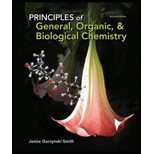
Concept explainers
(a)
Interpretation:
Chemical equation for conversion of
Concept Introduction:
1. Nitrogen-containing base
2. Pentose sugar
3. Phosphate group
Examples of nucleosides are GTP and ATP. Nucleotide on hydrolysis releases energy by cleavage of phosphoanhydride bond. The reaction of hydrolysis of ATP is as follows:
(b)
Interpretation:
Whether energy is released or absorbed in formation of
Concept Introduction:
Refer to part (a).
(c)
Interpretation:
Whether reaction is energetically favorable or not in formation of
Concept Introduction:
Refer to part (a).
Want to see the full answer?
Check out a sample textbook solution
Chapter 18 Solutions
Principles of General Organic & Biological Chemistry
- Define fermentation. Name the enzyme which converts(a) milk into curd (yogurt)(b) Cane sugar into glucose and fructose(c) glucose into ethanolarrow_forwardWhat is the product of the reaction when α-amylase acts on amylose? (A) amylose molecules (B) monosaccharide molecules (C) different-sized oligosaccharide fragments (D) different-sized polysaccharide fragmentsarrow_forwardMalate is converted to oxaloacetate by the enzyme malate dehydrogenase in the final reaction of the citrate cycle. This redox reaction results in the reduction of NAD+ to generate NADH + H+. Answer the three questions below and choose the correct answer. (a) Calculate the delta AE for the malate dehydrogenase reaction. (b) Calculate AG and determine if the conversion from malate to oxaloacetate is favorable under standard biochemical conditions using the information below. (c) Under cellular conditions is the AG favorable or unfavorable? Oxaloacetate + 2H* + 2e- --> Malate E° = -0.17 V NAD* + H+ + 2e- --> NADH E°' = -0.32 Varrow_forward
- From what you learned about monosaccharides in Chapter 20and phosphates in Chapter 23 : (a) Draw the structure of glucose 6-phosphate. (b) Using structures, write the equation for the hydrolysis of glucose 6-phosphate to glucose and HPO 42−.arrow_forwardGLYCOLYSIS: 1A) Starting with glucose (in the open-chain Fisher projection), draw out the molecular structures for each step of glycolysis. For each step, include the name of the enzyme that catalyzes the reaction. 1B) What is the net reaction of glycolysis? CITRIC ACID CYCLE: 2A) Starting with acetyl-coenzymeA and oxaloacetate, draw out the molecular structures for each step of the citric acid cycle. For each step, include the name of the enzyme that catalyzes the reaction. 2B) What is the net reaction of the citric acid cycle? What happens to each product? OXIDATIVE PHOSPHORYLATION: 3A) Thoroughly explain the biological significance of NADH/H* and FADH2 and their roles in oxidative phosphorylation. 3B) Describe and diagram the general pathway of the electrons from NADH/H+ and FADH₂ to O₂ during the electron transport chain. 3C) What is "chemiosmotic coupling", and what is its relationship to ATP synthesis? 3D) During oxidative phosphorylation, what is oxidized and what is…arrow_forward(a) Name the only vitamin which can be synthesized in our body. Name one disease that is caused due to the deficiency of this vitamin.(b) State two functions of carbohydrates.arrow_forward
- (a) Are galactose and mannose constitutional isomers or stereoisomers? (b) Draw the structure of galactose 1-phosphate and mannose 6-phosphate. (c) Are these two phosphates constitutional isomers or stereoisomers?arrow_forward5) The conversion of dihydroxyacetone phosphate (DHAP) to glyceraldehyde-3-phosphate in glycolysis has a AG" value of 7.5 kJ/mol, so the reaction should be unfavorable. a) Calculate the equilibrium constant for the reaction, based on this AG" value and assuming a temperature of 37 °C. b) For this reaction to occur spontaneously in the cell, glyceraldehyde-3-phosphate (GAP) levels are kept low. What is the value of AG if the concentration of GAP is kept at 1/100 that of the DHAP. 6) Energy can be harnessed as electrons move from compounds with low reduction potential to those with a higher reduction potential. This happens many times in the electron transport chain, where O, ultimately accepts the electrons. Using Table 3.6, determine the AG" for the transfer of electrons from glyceraldehyde-3-phosphate to produce H,0.arrow_forwardWrite a balanced equation for the synthesis of sucrosefrom glucose and fructose.arrow_forward
- (i) Which one of the following is a disaccharide : Starch, Maltose, Fructose, Glucose?(ii) What is the difference between fibrous protein and globular protein?(iii) Write the name of vitamin whose deficiency causes bones deformities in children.arrow_forwardWrite the products of oxidation of glucose with:(a) Bromine water (b) Nitric acidarrow_forwardThe first step of the metabolic process known as glycolysis is the conversion of glucose to glucose- 6-phosphate. This process has a positive value for rG' Glucose + Pi Glucose-6-phosphate + H2O rG' = +13.8 kJ/mol-rxn This reaction is coupled to the hydrolysis of ATP ATP + H2O ADP + Pi rG' = -30.5 kJ/mol-rxn What is the sum of these two equations and the value of rG' for the coupled reaction? Is the coupled reaction product-favored at equilibrium?arrow_forward
 Chemistry & Chemical ReactivityChemistryISBN:9781337399074Author:John C. Kotz, Paul M. Treichel, John Townsend, David TreichelPublisher:Cengage Learning
Chemistry & Chemical ReactivityChemistryISBN:9781337399074Author:John C. Kotz, Paul M. Treichel, John Townsend, David TreichelPublisher:Cengage Learning Chemistry & Chemical ReactivityChemistryISBN:9781133949640Author:John C. Kotz, Paul M. Treichel, John Townsend, David TreichelPublisher:Cengage Learning
Chemistry & Chemical ReactivityChemistryISBN:9781133949640Author:John C. Kotz, Paul M. Treichel, John Townsend, David TreichelPublisher:Cengage Learning Chemistry for Today: General, Organic, and Bioche...ChemistryISBN:9781305960060Author:Spencer L. Seager, Michael R. Slabaugh, Maren S. HansenPublisher:Cengage Learning
Chemistry for Today: General, Organic, and Bioche...ChemistryISBN:9781305960060Author:Spencer L. Seager, Michael R. Slabaugh, Maren S. HansenPublisher:Cengage Learning Introduction to General, Organic and BiochemistryChemistryISBN:9781285869759Author:Frederick A. Bettelheim, William H. Brown, Mary K. Campbell, Shawn O. Farrell, Omar TorresPublisher:Cengage Learning
Introduction to General, Organic and BiochemistryChemistryISBN:9781285869759Author:Frederick A. Bettelheim, William H. Brown, Mary K. Campbell, Shawn O. Farrell, Omar TorresPublisher:Cengage Learning Chemistry In FocusChemistryISBN:9781305084476Author:Tro, Nivaldo J., Neu, Don.Publisher:Cengage LearningChemistry: Matter and ChangeChemistryISBN:9780078746376Author:Dinah Zike, Laurel Dingrando, Nicholas Hainen, Cheryl WistromPublisher:Glencoe/McGraw-Hill School Pub Co
Chemistry In FocusChemistryISBN:9781305084476Author:Tro, Nivaldo J., Neu, Don.Publisher:Cengage LearningChemistry: Matter and ChangeChemistryISBN:9780078746376Author:Dinah Zike, Laurel Dingrando, Nicholas Hainen, Cheryl WistromPublisher:Glencoe/McGraw-Hill School Pub Co





